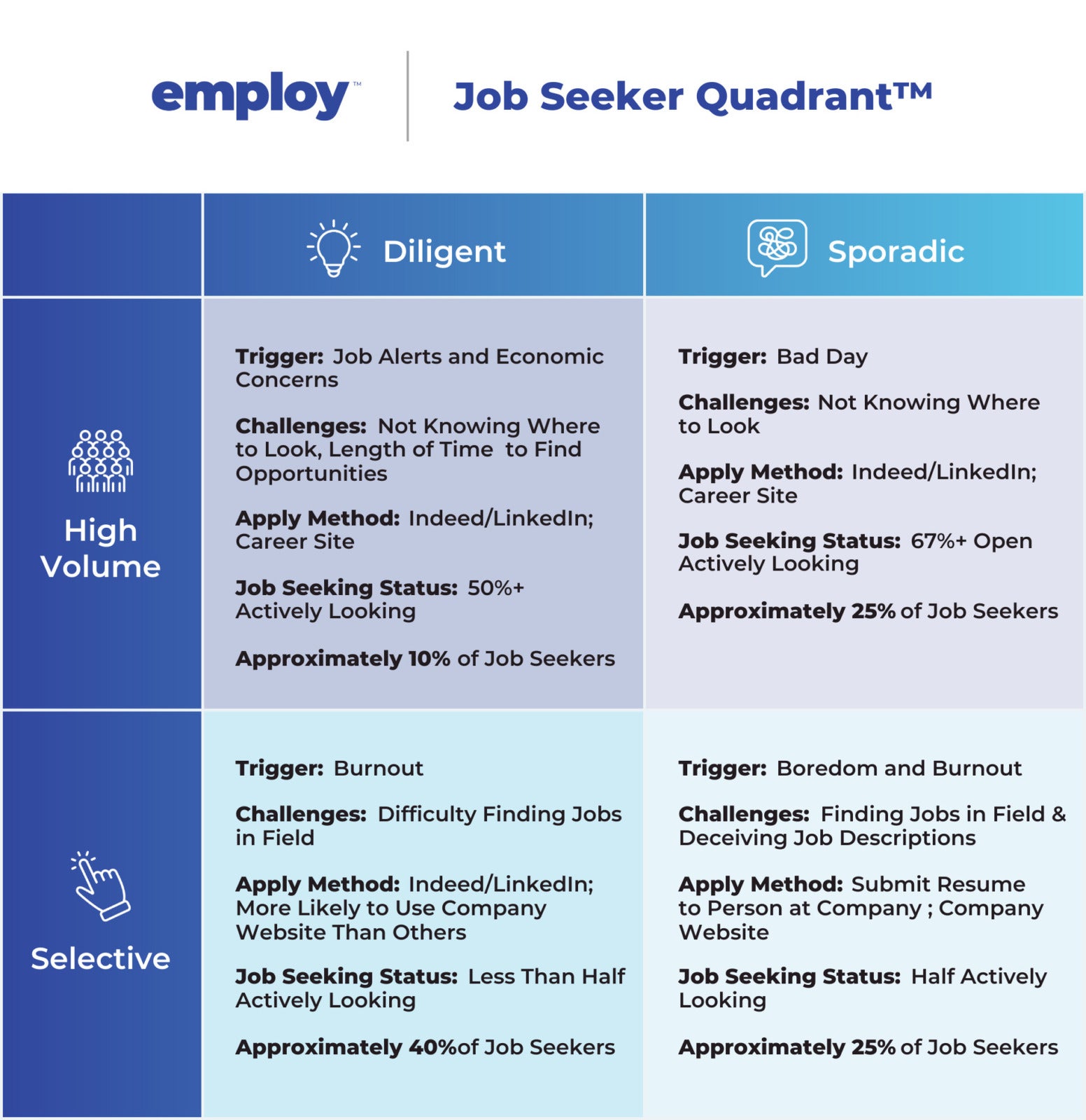For employers today, understanding job seekers’ mindset and behavior is critical to connecting with them more effectively and staying competitive in a tight and uncertain labor market.
Without knowing what to prioritize, it can be difficult for employers to determine what candidates respond to, what their motivations are, and how to effectively engage with them.
- Based on the latest job seeker data, Employ has identified four key personas that recruiters and hiring teams should look for when evaluating candidates to optimize their hiring process.
By understanding these four categories of job seekers, talent acquisition teams can better understand their ideal candidates and, therefore, better engage with them.
The Job Seeker Quadrant™: Four candidate personas that exist in today’s job market
Based on Employ’s research, candidates fall into one of four quadrants in their job-seeking behavior. The four types of job seekers are:
- Diligent/High-Volume Job Seekers
- Sporadic/High-Volume Job Seekers
- Diligent/Selective Job Seekers
- Sporadic/Selective Job Seekers

Diligent/High-Volume Job Seekers
Candidates who make up this persona are likely to look internally in their organizations for new jobs and make up just one in 10 job seekers.
They are motivated by job alerts they receive or by overall economic concerns in the current market. Frequently updating their resume, these candidates will apply even if they doubt the employer is hiring.
- Prospects also get frustrated with the application process and abandon it if it takes too long.
Most of these candidates are optimistic it will take them less than one month to find a new job and will apply for a job with a large salary range.
These candidates are racially diverse and seek new roles with strong company leadership. Concerned about the company’s financial position, these job seekers often use social media and subscribe to job advertisements.
The way to make a big impact on these candidates is by offering an easy interview scheduling process.
Sporadic/High-Volume Job Seekers
Candidates characterized by this persona are the most satisfied in their current job and make up one-quarter of all job seekers. They are most likely to apply with no intention of taking a new job.
These job seekers are also most likely to look internally for new roles within their current company and to frequently update their resumes.
While these candidates skew younger in age, they are also most likely to apply for a job with a large salary range. Candidates in this group have typically taken a new job in the past 12 months, and one of their primary motivations is looking for career advancement opportunities.
- These individuals are also highly in tune and concerned with the company’s financial position.
From a job search perspective, they regularly search via job boards, are impressed by easy scheduling, and abandon job applications if they require registration.
Most are acceptable if they don’t hear back from employers for jobs they’ve applied to, but typically receive the greatest number of automated and impersonal rejection notes.
Diligent/Selective Job Seekers
Candidates who fall into this persona make up the largest number of job seekers currently.
They are less likely to look internally within their current organization for new roles and less likely to apply for a new job if they believe an employer won’t hire them for the position. They are more likely to abandon a job application if it takes too long.
- Half of these job seekers are unlikely to apply for a job with a large salary range. While these candidates expect to work with an outsourced recruiter, they have a low likelihood of ghosting recruiters in general.
This group of job seekers also typically attributes explaining a company’s mission and values as a good candidate experience. And from a job application perspective, they are more likely to look and use a company’s website in applying for roles than other personas.
Sporadic/Selective Job Seekers
Candidates characterized as this persona are the least likely of any candidate type to apply internally for open roles. They expect to submit the fewest applications to get a new job and are least likely of any group to use social media to update their resumes for an application or apply to a job with a very large salary range.
- This group of job seekers has a greater proportion of older workers, including Baby Boomers and Generation X, and are least likely to apply for a role if they believe the employer won’t hire them.
Candidates in this category are also unlikely to put significant amounts of time into an application or to have learned a new skill in the past 12 months.
While unlikely to be ghosted by a recruiter or to ghost a recruiter themselves, they are also least accepting of not hearing back from an employer. These candidates also believe the hiring process takes too long and want personal rejection notes, emails, or notices if not selected for a role.
Applying personas in the Job Seeker Quadrant
The Job Seeker Quadrant™ and the persona descriptions provided here serve as a guide for companies and talent acquisition teams as they seek to get to know the motivations, triggers, characteristics, and behaviors of candidates looking for new roles in the current labor market.
By understanding the different motivations and needs of each persona type, employers have a better chance of matching their hiring process with those expectations.
Continue exploring new job seeker insights
As employers face unfamiliar territory in the current labor market (and will likely continue to for the foreseeable future), they need guidance and the latest insights to support their hiring efforts.
The Q1 2023 Employ Quarterly Insights Report examines employer data across Employ’s 18,000 customers, while exploring the motivations, similarities, and differences of workers based on a survey of more than 1,500 workers.
Download the report to discover how to better appeal to these candidate personas.




